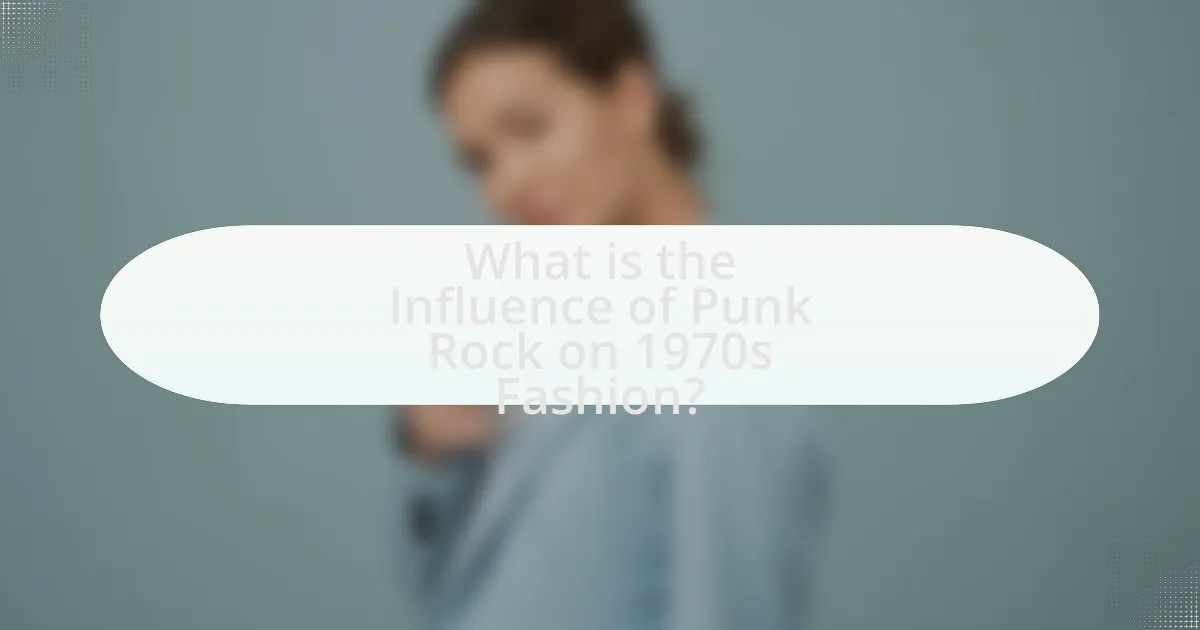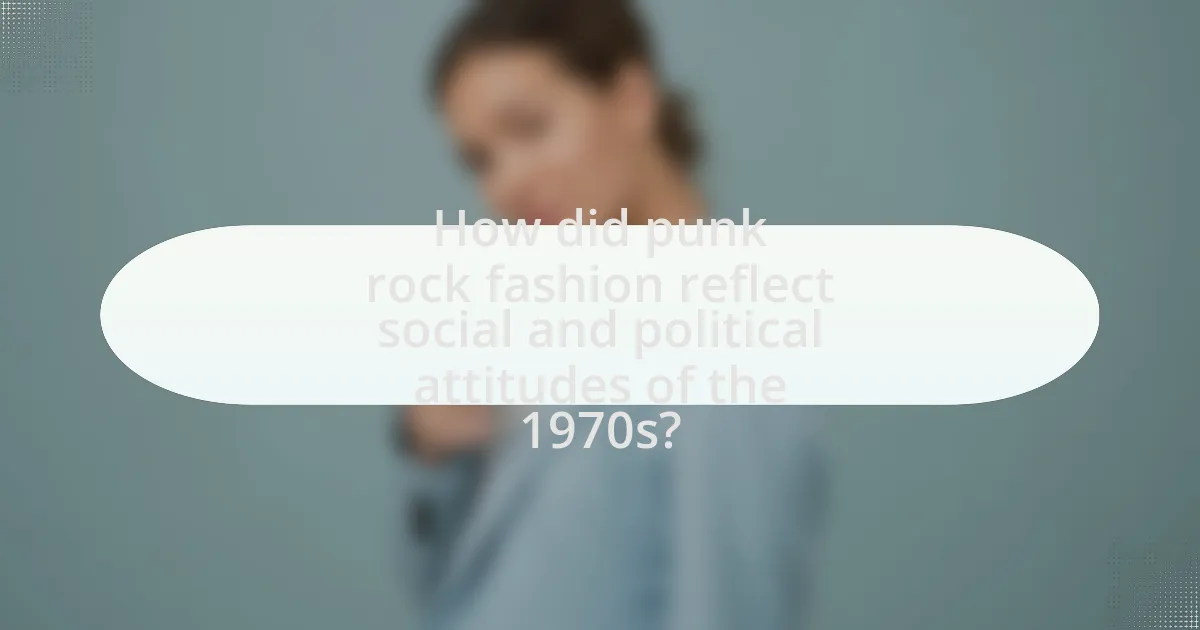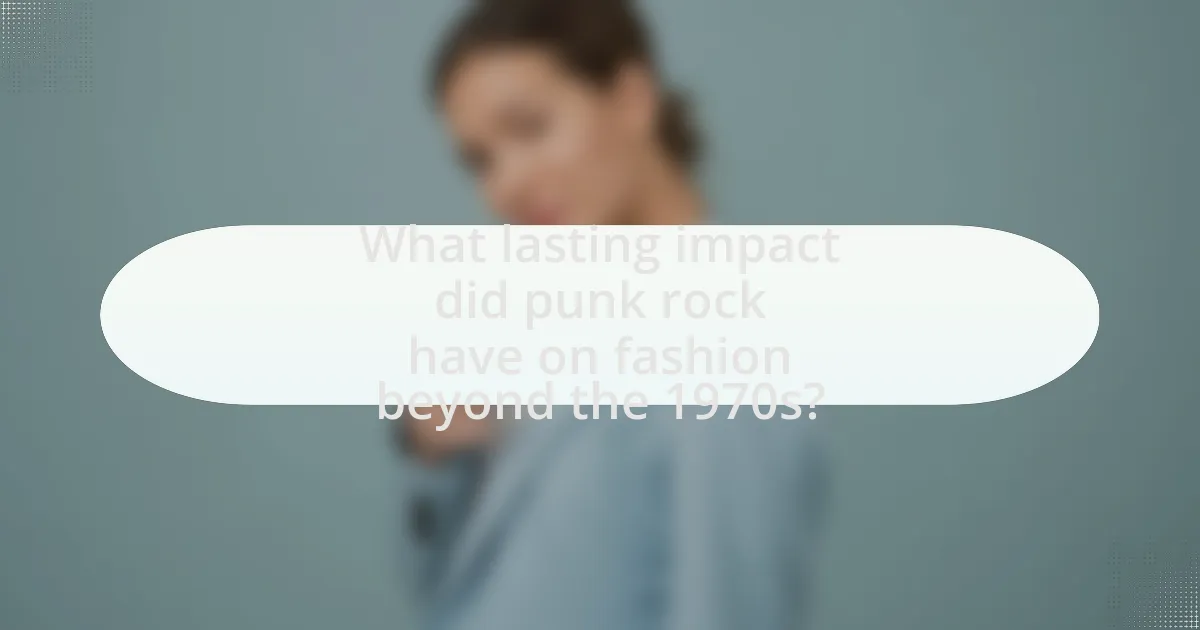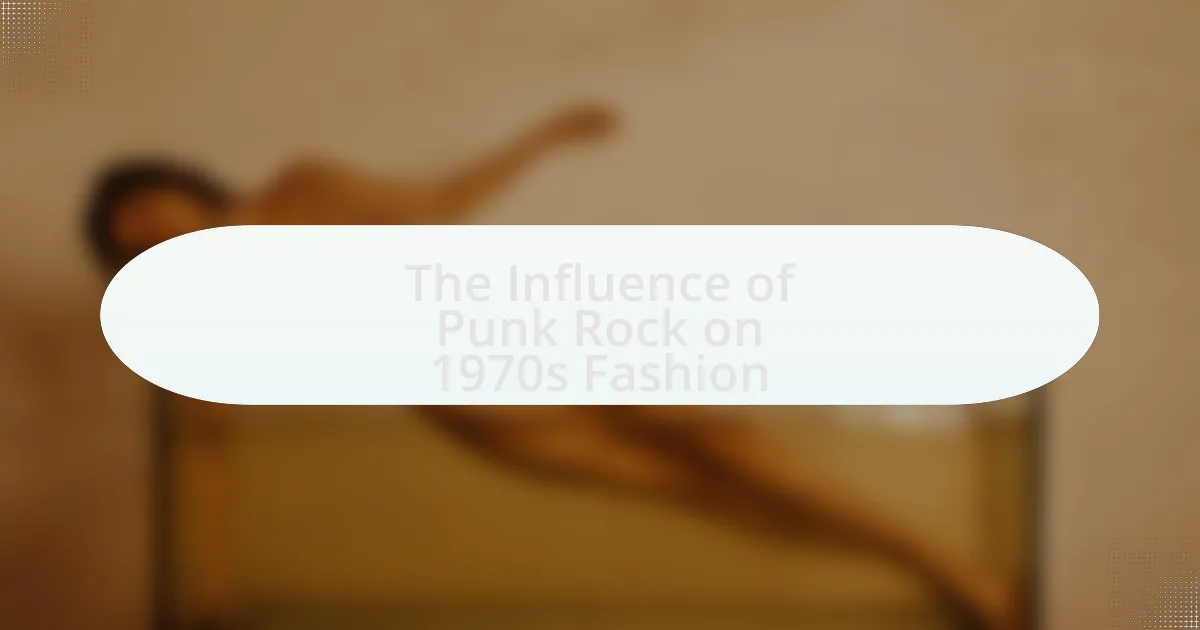The article examines the significant influence of punk rock on 1970s fashion, highlighting how the movement introduced a rebellious aesthetic characterized by DIY elements, bold graphics, and unconventional styles. It discusses the emergence of punk as a cultural movement, its key characteristics, and the role of iconic bands like the Sex Pistols and The Ramones in shaping fashion trends. The article also explores how punk fashion challenged existing norms, reflected social and political attitudes of the time, and evolved throughout the decade, ultimately leaving a lasting impact on contemporary fashion and inspiring modern designers.

What is the Influence of Punk Rock on 1970s Fashion?
Punk rock significantly influenced 1970s fashion by introducing a rebellious aesthetic characterized by DIY elements, bold graphics, and unconventional styles. This movement emerged as a reaction against the mainstream culture of the time, leading to the popularity of items such as leather jackets, ripped jeans, and band t-shirts. Designers like Vivienne Westwood and Malcolm McLaren played pivotal roles in shaping this style, promoting a look that embraced anti-establishment sentiments. The punk fashion scene also incorporated accessories like safety pins and studs, which became symbols of the movement. This shift in fashion not only reflected the attitudes of punk rock musicians but also inspired broader cultural changes, making punk a defining style of the 1970s.
How did punk rock emerge as a cultural movement in the 1970s?
Punk rock emerged as a cultural movement in the 1970s primarily as a reaction against the mainstream music industry and societal norms. This movement was characterized by its raw sound, anti-establishment lyrics, and a DIY ethic that rejected the polished production of popular music at the time. Key events, such as the formation of influential bands like the Ramones, Sex Pistols, and The Clash, along with iconic venues like CBGB in New York City, played a crucial role in shaping the punk scene. The movement also drew inspiration from earlier garage rock and protopunk bands, creating a distinct identity that resonated with disaffected youth. The punk ethos emphasized individuality and rebellion, which significantly influenced not only music but also fashion, leading to the adoption of distinctive styles such as ripped clothing, leather jackets, and bold hairstyles.
What were the key characteristics of punk rock music and ideology?
Punk rock music and ideology are characterized by their raw sound, anti-establishment themes, and a DIY (do-it-yourself) ethos. The music typically features fast tempos, short song durations, and simple chord progressions, often accompanied by aggressive vocals. Ideologically, punk rock promotes individualism, rebellion against societal norms, and a critique of mainstream culture, as exemplified by bands like the Sex Pistols and The Ramones. The genre emerged in the mid-1970s, reflecting disillusionment with political and social issues of the time, such as economic instability and cultural conformity. This combination of musical style and ideological stance has made punk rock a significant cultural movement, influencing not only music but also fashion, art, and social attitudes.
How did punk rock challenge the existing fashion norms of the time?
Punk rock challenged the existing fashion norms of the 1970s by promoting a DIY aesthetic that rejected mainstream styles. This movement embraced unconventional clothing, such as ripped jeans, leather jackets, and graphic T-shirts, which contrasted sharply with the polished looks of the era. Punk bands like the Sex Pistols and The Ramones popularized this rebellious fashion, often incorporating elements like safety pins and spikes, symbolizing anti-establishment sentiments. The punk fashion movement was further solidified by influential designers like Vivienne Westwood, who created iconic pieces that embodied the punk ethos, thus reshaping the fashion landscape and encouraging individual expression over conformity.
What role did iconic punk bands play in shaping fashion trends?
Iconic punk bands played a crucial role in shaping fashion trends by introducing a rebellious aesthetic that challenged mainstream styles. Bands like the Sex Pistols and The Ramones popularized elements such as leather jackets, ripped jeans, and graphic tees, which became symbols of anti-establishment sentiment. This fashion movement was characterized by DIY (do-it-yourself) ethos, encouraging fans to customize their clothing, further influencing street style and high fashion alike. The punk fashion revolution not only reflected the music’s raw energy but also inspired designers like Vivienne Westwood, who incorporated punk elements into their collections, solidifying the genre’s lasting impact on the fashion industry.
Which bands were most influential in the punk fashion scene?
The most influential bands in the punk fashion scene were the Sex Pistols, The Clash, and Ramones. The Sex Pistols, known for their rebellious attitude and distinctive style, popularized elements like leather jackets, ripped clothing, and provocative imagery, which became staples of punk fashion. The Clash contributed to the scene by incorporating diverse influences, including military and workwear aesthetics, while promoting anti-establishment messages through their clothing choices. The Ramones, with their iconic denim jackets and T-shirts, established a uniform that defined punk style. These bands collectively shaped the visual identity of punk rock in the 1970s, influencing not only music but also fashion trends that persist today.
How did band members’ personal styles impact their fans and the fashion industry?
Band members’ personal styles significantly influenced their fans and the fashion industry by popularizing distinctive, rebellious aesthetics that challenged mainstream norms. For instance, artists like Johnny Rotten of the Sex Pistols and Debbie Harry of Blondie adopted bold clothing choices, such as ripped clothing, leather jackets, and vibrant hairstyles, which resonated with youth culture and encouraged fans to express their individuality. This shift led to a surge in punk-inspired fashion lines in the late 1970s, with designers like Vivienne Westwood and Malcolm McLaren capitalizing on the movement, ultimately shaping the broader fashion landscape. The punk rock scene’s emphasis on self-expression and anti-establishment sentiments not only inspired fans to adopt similar styles but also prompted major fashion retailers to incorporate punk elements into their collections, demonstrating the profound impact of band members’ personal styles on both fans and the fashion industry.
What were the main fashion elements associated with punk rock?
The main fashion elements associated with punk rock include leather jackets, ripped clothing, band t-shirts, and distinctive hairstyles such as mohawks. These elements emerged in the 1970s as a rebellion against mainstream fashion, characterized by a DIY ethos and a focus on individuality. The use of safety pins, studs, and spikes further emphasized the anti-establishment attitude of the punk movement, which was also reflected in the bold use of color and graphic prints. Historical context shows that bands like the Sex Pistols and The Ramones popularized these styles, influencing youth culture and fashion significantly during that era.
What types of clothing and accessories became popular in punk fashion?
Punk fashion became characterized by specific types of clothing and accessories that included leather jackets, ripped jeans, band t-shirts, and combat boots. These items were often adorned with spikes, studs, and safety pins, reflecting the rebellious ethos of the punk movement. The use of DIY aesthetics, such as customized clothing and unique hairstyles, further emphasized individuality and anti-establishment sentiments. Historical context shows that punk fashion emerged in the mid-1970s, influenced by bands like the Sex Pistols and The Ramones, who popularized this distinctive style.
How did DIY culture influence punk fashion choices?
DIY culture significantly influenced punk fashion choices by promoting individualism and self-expression through customized clothing. Punk enthusiasts often rejected mainstream fashion, opting instead for handmade garments, alterations, and unique accessories that reflected their personal beliefs and attitudes. This movement was characterized by the use of thrifted materials, safety pins, and bold graphics, which became staples in punk attire. The ethos of DIY was rooted in the punk philosophy of anti-commercialism, encouraging fans to create their own styles rather than conforming to established fashion norms. This approach not only democratized fashion but also allowed for a diverse range of expressions within the punk community, solidifying DIY culture as a foundational element of punk fashion.

How did punk rock fashion reflect social and political attitudes of the 1970s?
Punk rock fashion reflected the social and political attitudes of the 1970s by embodying rebellion against mainstream culture and authority. This fashion movement utilized elements such as ripped clothing, safety pins, and bold hairstyles to challenge societal norms and express discontent with political issues, including economic instability and social inequality. For instance, the use of DIY aesthetics in punk fashion symbolized a rejection of consumerism and a call for individualism, aligning with the anti-establishment sentiments prevalent during that era. The Sex Pistols, a prominent punk band, famously wore provocative attire that critiqued the British monarchy and government, further illustrating how punk fashion served as a visual representation of the era’s unrest and desire for change.
What social issues were expressed through punk fashion?
Punk fashion expressed social issues such as anti-establishment sentiments, class struggle, and rebellion against societal norms. This style emerged in the 1970s as a reaction to political disillusionment, economic hardship, and cultural conservatism. For instance, the use of DIY aesthetics and provocative imagery in punk clothing symbolized a rejection of mainstream fashion and consumerism, highlighting the frustrations of youth facing unemployment and social inequality. Additionally, punk fashion often incorporated elements that challenged gender norms and embraced sexual liberation, reflecting broader movements for rights and feminism during that era.
How did punk fashion serve as a form of rebellion against mainstream culture?
Punk fashion served as a form of rebellion against mainstream culture by deliberately rejecting conventional styles and embracing a DIY ethos. This movement emerged in the 1970s as a response to societal norms, characterized by the use of torn clothing, leather jackets, and provocative accessories, which symbolized a rejection of the polished aesthetics of the time. The adoption of bold hairstyles, such as brightly colored spikes, further emphasized individuality and nonconformity. Punk fashion was not just about clothing; it was a statement against consumerism and the commercialization of culture, as seen in the use of second-hand materials and self-made garments. This defiance was exemplified by influential bands like the Sex Pistols and The Clash, whose members embodied the punk aesthetic, reinforcing the idea that fashion could be a powerful tool for social and political commentary.
What messages were conveyed through the use of specific symbols and styles?
The use of specific symbols and styles in punk rock fashion conveyed messages of rebellion, individuality, and anti-establishment sentiments. For instance, the safety pin symbolized a DIY ethos and a rejection of mainstream fashion norms, while leather jackets represented a tough, non-conformist identity. Additionally, bold colors and graphic designs often featured political statements or critiques of societal norms, reinforcing the punk movement’s challenge to authority and traditional values. This visual language was integral in expressing the frustrations and aspirations of youth during the 1970s, making punk fashion a powerful medium for social commentary.
How did punk rock fashion evolve throughout the decade?
Punk rock fashion evolved significantly throughout the 1970s, transitioning from a raw, DIY aesthetic to a more commercialized and diverse style. Initially characterized by ripped clothing, leather jackets, and band t-shirts, punk fashion was a form of rebellion against mainstream culture, exemplified by figures like Malcolm McLaren and Vivienne Westwood, who popularized the look in their London boutique, SEX. As the decade progressed, punk fashion began to incorporate elements from other styles, including glam rock and new wave, leading to a broader acceptance and adaptation of punk aesthetics in mainstream fashion. By the late 1970s, punk influences were evident in high fashion, with designers like Jean-Paul Gaultier and Yves Saint Laurent drawing inspiration from punk’s edgy visuals, thus solidifying its impact on the fashion landscape of the era.
What changes occurred in punk fashion from the early to late 1970s?
Punk fashion evolved significantly from the early to late 1970s, transitioning from a raw, DIY aesthetic to a more commercialized and diverse style. In the early 1970s, punk fashion was characterized by torn clothing, leather jackets, and a rebellious attitude, often featuring elements like safety pins and band t-shirts, which symbolized anti-establishment sentiments. By the late 1970s, punk fashion began to incorporate more varied influences, including high fashion elements, as designers like Vivienne Westwood and Malcolm McLaren introduced punk styles into mainstream fashion, leading to a blend of punk with glam and new wave aesthetics. This shift was marked by the emergence of more polished looks, including tailored jackets and vibrant colors, reflecting a broader acceptance of punk culture in society.
How did the commercialization of punk affect its fashion trends?
The commercialization of punk significantly altered its fashion trends by transforming raw, DIY aesthetics into mainstream styles. Initially characterized by elements like ripped clothing, safety pins, and bold hairstyles, punk fashion became commodified as major retailers began to adopt and sell these styles, often stripping them of their original rebellious context. For example, in the late 1970s, brands like Vivienne Westwood and Malcolm McLaren’s Sex boutique popularized punk fashion, leading to a wider acceptance and commercialization of items such as leather jackets and graphic tees. This shift not only diluted the subculture’s anti-establishment message but also led to the emergence of punk-inspired fashion lines in high street stores, making punk aesthetics accessible to a broader audience.

What lasting impact did punk rock have on fashion beyond the 1970s?
Punk rock significantly influenced fashion beyond the 1970s by introducing a rebellious aesthetic characterized by DIY elements, bold graphics, and a mix of high and low fashion. This movement led to the widespread adoption of styles such as ripped clothing, leather jackets, and combat boots, which became staples in various subcultures and mainstream fashion. The punk ethos of individuality and anti-establishment sentiment continued to resonate, inspiring designers like Vivienne Westwood and Jean-Paul Gaultier, who incorporated punk elements into their collections throughout the 1980s and beyond. The impact is evident in the ongoing popularity of punk-inspired fashion in contemporary streetwear and high fashion, demonstrating its lasting legacy in the fashion industry.
How has punk rock influenced contemporary fashion designers?
Punk rock has significantly influenced contemporary fashion designers by introducing elements of rebellion, DIY aesthetics, and a focus on individuality. Designers such as Vivienne Westwood and Jean-Paul Gaultier have incorporated punk-inspired motifs, such as safety pins, leather jackets, and tartan patterns, into their collections, reflecting the anti-establishment ethos of the punk movement. This influence is evident in the rise of streetwear and the blending of high fashion with casual, edgy styles, which challenge traditional fashion norms. The punk rock movement’s emphasis on self-expression and nonconformity continues to resonate in contemporary fashion, shaping trends and inspiring new generations of designers.
Which modern fashion movements can trace their roots back to punk rock?
Modern fashion movements that can trace their roots back to punk rock include streetwear, grunge, and goth fashion. Streetwear emerged in the 1980s and 1990s, influenced by the rebellious spirit and DIY ethos of punk, characterized by graphic tees, oversized silhouettes, and urban aesthetics. Grunge fashion, popularized in the early 1990s, drew heavily from punk’s anti-establishment attitude, featuring flannel shirts, ripped jeans, and a generally unkempt appearance. Goth fashion, which developed in the late 1970s and 1980s, also shares punk’s roots, emphasizing dark clothing, dramatic makeup, and a focus on individuality and self-expression. These movements reflect punk rock’s lasting impact on contemporary fashion, showcasing its influence on style, identity, and cultural expression.
How do current fashion trends reflect the ethos of punk rock?
Current fashion trends reflect the ethos of punk rock through the incorporation of rebellious styles, DIY aesthetics, and a focus on individuality. Designers and brands often utilize elements such as distressed fabrics, bold graphics, and unconventional silhouettes, which echo the original punk movement’s challenge to societal norms. For instance, the resurgence of leather jackets, graphic tees, and combat boots in contemporary fashion mirrors the punk rock ethos of defiance and self-expression. Additionally, the popularity of upcycled and customized clothing aligns with the punk principle of rejecting mass production, emphasizing personal creativity and sustainability. This connection is evident in collections from brands like Vivienne Westwood, who has consistently drawn inspiration from punk culture, reinforcing its lasting impact on modern fashion.
What can we learn from the influence of punk rock on fashion today?
Punk rock has significantly influenced contemporary fashion by promoting individualism and anti-establishment aesthetics. This influence is evident in the widespread adoption of elements such as ripped clothing, leather jackets, and bold graphic tees, which challenge mainstream fashion norms. The punk movement, originating in the 1970s, emphasized self-expression and rebellion against societal expectations, a principle that continues to resonate in today’s fashion landscape. For instance, designers like Vivienne Westwood, who played a pivotal role in the punk scene, have shaped modern fashion by integrating punk elements into high fashion, demonstrating the lasting impact of punk rock on style choices.
How can individuals incorporate punk-inspired elements into their personal style?
Individuals can incorporate punk-inspired elements into their personal style by integrating key fashion items such as leather jackets, band t-shirts, ripped jeans, and combat boots. These items are foundational to punk aesthetics, which emerged in the 1970s as a rebellion against mainstream fashion. For example, the leather jacket symbolizes defiance and individuality, while band t-shirts showcase personal music preferences and cultural affiliations. Additionally, accessories like studded belts, safety pins, and bold hairstyles, such as mohawks or brightly colored hair, further enhance the punk look. Historical context shows that punk fashion was not just about clothing but also about expressing a countercultural identity, making these elements significant in conveying personal style.
What are some best practices for embracing punk fashion in a modern context?
To embrace punk fashion in a modern context, individuals should focus on incorporating bold, DIY elements, mixing vintage and contemporary pieces, and expressing personal identity through unique styles. Punk fashion originally emerged in the 1970s as a form of rebellion against mainstream culture, characterized by leather jackets, ripped clothing, and distinctive accessories. Modern practitioners can honor this heritage by customizing garments, such as adding patches or studs, which reflects the original punk ethos of individuality and self-expression. Additionally, blending punk aesthetics with current trends, like pairing combat boots with modern streetwear, allows for a fresh take while maintaining the punk spirit. This approach not only respects the historical roots of punk fashion but also adapts it to contemporary sensibilities, ensuring relevance in today’s fashion landscape.

Leave a Reply